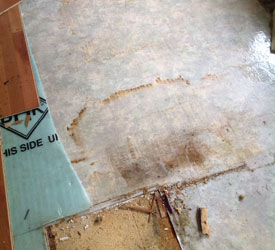Usual Root Causes Of Water Damage in a Bathroom
Usual Root Causes Of Water Damage in a Bathroom
Blog Article
Do you find yourself hunting for facts and techniques on Looking for Signs of Water Damage in the Bathroom?

The bathroom is very susceptible for wet build-up and prospective water damages because of the frequent use water in it. This article supplies simple assessment strategies to assist identifying water damage dangers.
The frequent use of water in the bathroom makes it very vulnerable for damp buildup as well as possible water damage. By examining it regularly, you can reduce water related damages.
The adhering to set of examinations is easy to do and also should be done when in every 3 months in order to keep your shower room in good shape and to avoid prospective water problems brought on by the bathtub, the shower, pipe joints as well as plumbing, sinks, cupboards, as well as the commode
Do not neglect performing these evaluations as well as be comprehensive while doing them. Bear in mind that these easy evaluations can save you a great deal of money by supplying early indicators for water damages
Tub and also Shower
The shower and also tub need unique focus and maintenance. Check the ceramic tiles as well as change if fractured. Make sure that there is no missing grout between the ceramic tiles. Check as well as replace split caulking at joints where the walls satisfy the floor or the tub. Blocked drains pipes as well as pipelines troubles will certainly protect against the bathtub from drying and may suggest major issues underneath the tub. Talk to an expert promptly to stop architectural damage. Take note of discolorations or soft areas around the bath tub wall surfaces as they might suggest an internal leak.
Plumbing
Signs for water damages are tough to find since most pipelines are set up inside the walls.
Pay special focus to floor covering as well as walls moisture and also discolorations as they might suggest an unnoticeable plumbing trouble. Examine wetness levels in adjacent spaces also.
Sinks and Cabinets
Sinks and also cabinets are revealed to wetness and moisture day-to-day and also are usually forgotten. Check on a regular basis under the sink as well as on the counter top above it. Fix any kind of drip in the trap as it might suggest drain problems. Check out the sink, slow-moving draining pipelines may indicate an obstructed drain. Replace sink seals if they are fractured or loosened.
The Bathroom
The toilet is an at risk water joint. Check the water lines and look for leaks around the toilet seat, in the tube, as well as under the water tank. If you detect any kind of indications of moisture on the flooring around the bathroom, look for leakages in the toilet rim and also storage tank seals.
Understand that hanging commode dish deodorants raises the possibilities for clogs.
TIPS TO PREVENT WATER DAMAGE IN THE BATHROOM
The average household uses approximately 80-100 gallons of water per person per day. For a family of 4, that's almost 2,500 gallons of water a week! The largest portion of this consumption comes from bathroom use. Flushing the toilet uses the most water, followed by taking a shower or bath. With that much water running through the home, water damage in the bathroom is bound to happen. Knowing how to spot signs of a water leak is essential to preventing long-term damage. This guide provides you with tips to reduce the impact of water damage on your bathroom.
CAUSES OF BATHROOM WATER DAMAGE
Pipe breaks are the most common cause of water damage we see in our daily jobs. The age of a pipe plays a large role in a pipe break as well as corrosion. Over time, the metal begins to break down, allowing water to escape. Frozen pipe breaks are also a concern in the winter months. Toilet overflows caused by paper products or children flushing inappropriate items. Degraded caulking around the toilet or bathtub can allow water seepage, sometimes behind the fixture, into the subfloor or walls. Condensation forms when the water in a pipe is cooler than the air temperature. Beads of water form on the exterior of the pipes, sometimes so much so that the water begins to drip and pool below. Sink or shower backups created by poor drainage. HOW TO PREVENT WATER DAMAGE IN YOUR BATHROOM
Inspect your toilet supply line for worn or frayed hoses and replace them as needed. Winterize your plumbing to prevent a frozen pipe break. Use vent fans to prevent condensation that can lead to mold growth. Routinely check and replace degraded caulking around your toilet or bathtub. Increase the temperature in your toilet tank and insulate your pipes during the warm summer months to keep condensation from forming. Use child safety locks on the toilets. Flush only toilet paper. "Flushable" wet wipes are actually not good for your plumbing system. Additionally, feminine hygiene products should not be flushed. Prevent water from escaping the tub or shower. Make sure shower curtains are in good condition. Inspect shower doors and replace the seal strip if necessary. Wipe up any water that accumulates on the floor and use bath mats. Water left to sit can cause damage to the tiles and flooring. Refrain from using bath products containing heavy oils to avoid a clogged drain.

Do you like reading about Common Causes of Water Damage in a Bathroom? Try to leave feedback down below. We'd be glad to see your ideas about this entry. We are looking forward that you come back again later on. Sharing is nice. Who knows, you may very well be doing someone a favor. I treasure reading our article about Preventing Water Damage in the Bathroom.
Book Now Report this page